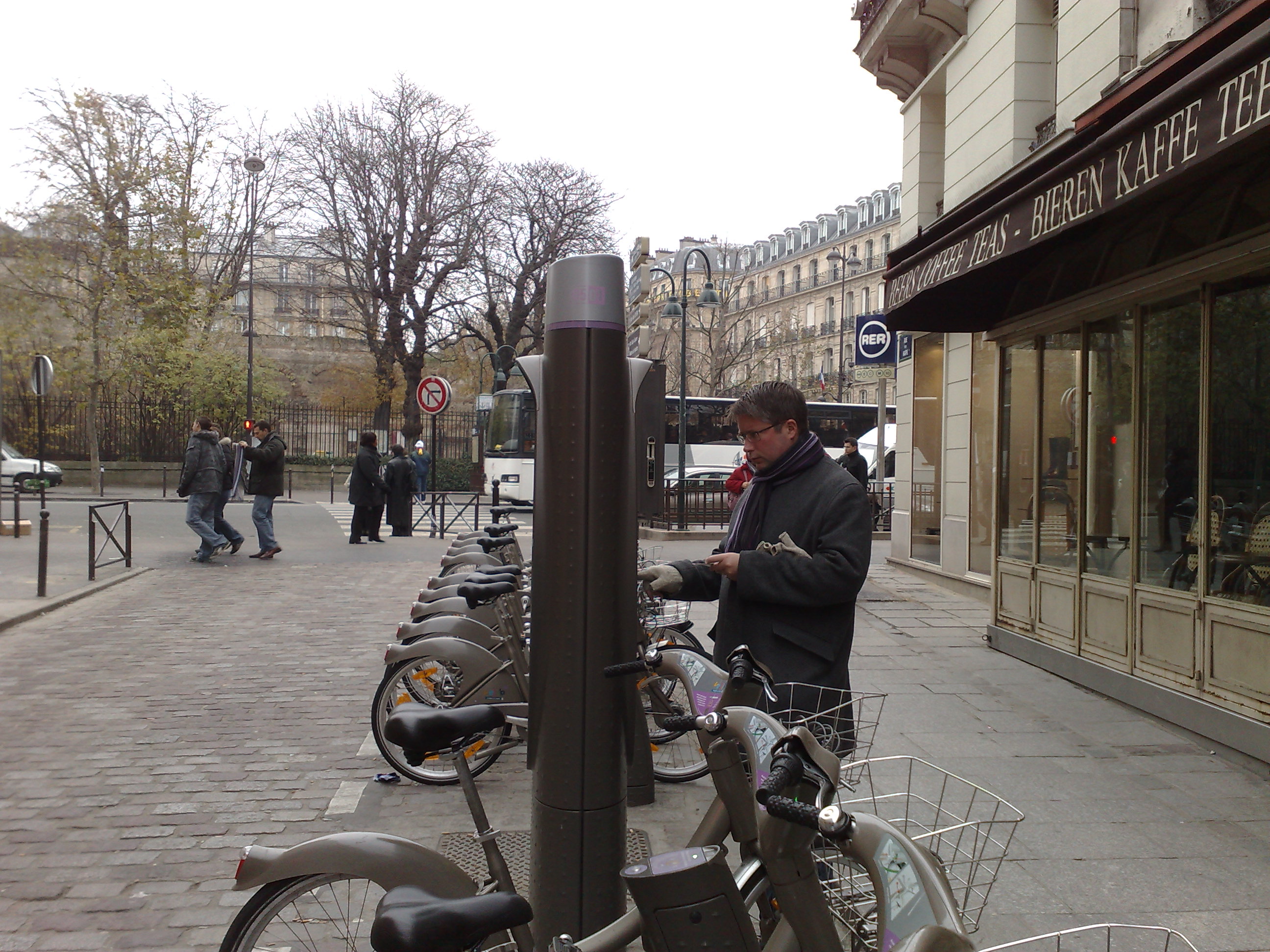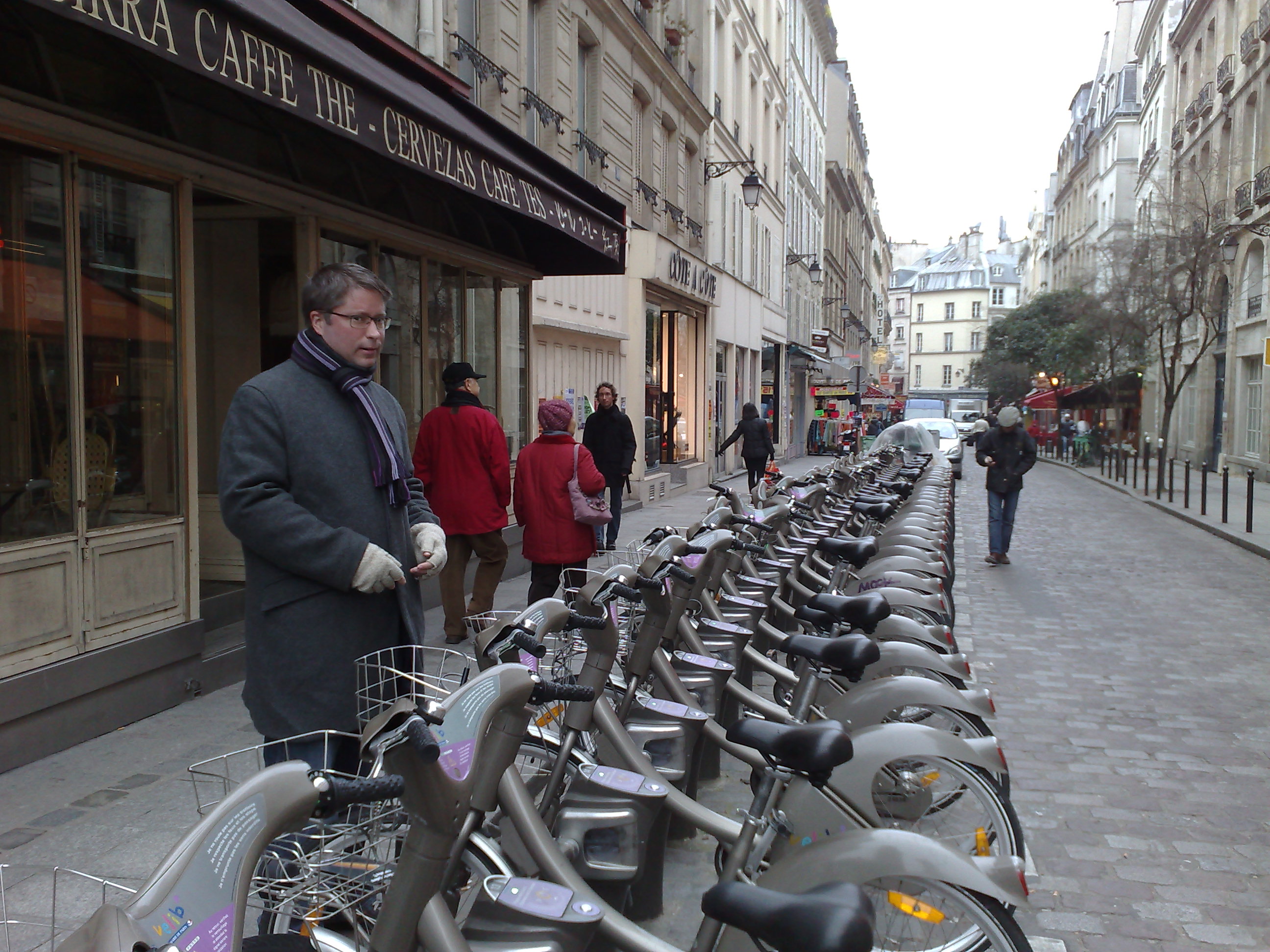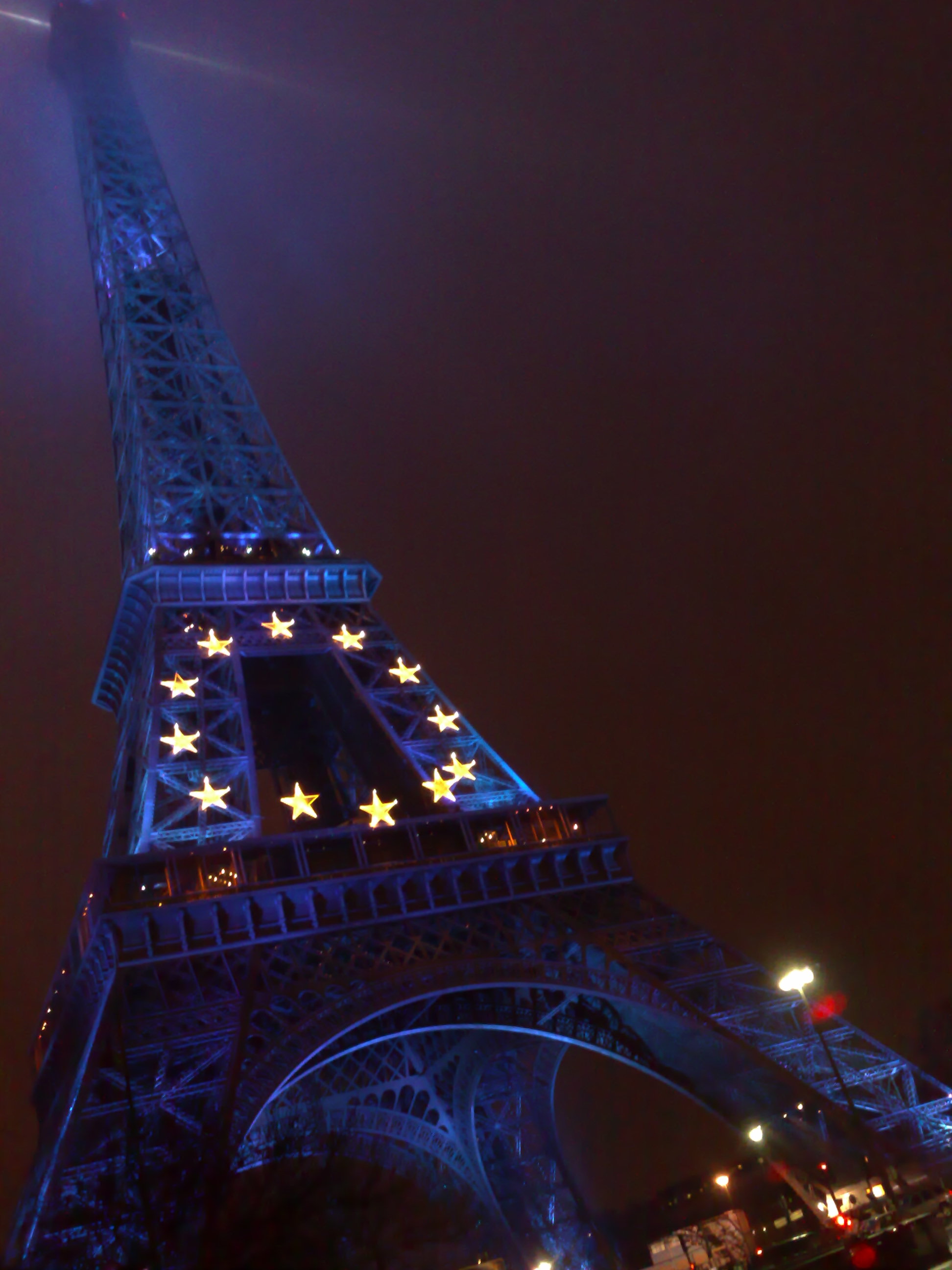December 12th, 2009 — design, geography, philosophy, travel, trends
Having just returned from the Le Web conference in Paris and having once again thoroughly enjoyed their Velib’ municipal bike-sharing system, I continue to be inspired to do as much as possible via bicycle.
I try to bike as a form of functional transportation, not just for exercise. If you start to think about biking as a way of getting around, a lot of the dysfunctional design of our cities and suburbs becomes evident.
Today our family was faced with the task of obtaining a Christmas tree, and wanting to get out for a bike ride I immediately thought this was something we could accomplish via bike. This summer when I attended TED Global in Oxford, I flew to Heathrow airport with my bike and then rode from there to Oxford (about 50 miles) with a 30 pound pack on my back. So a Christmas tree (20 pounds?) over 5 miles seemed no problem in comparison.
So this afternoon our family biked to a local produce stand and purchased a tree. We put it into a US Army standard-issue duffle and secured that to my back using cargo straps.

Here’s me in my fully mobile glory:

And here, on the Baltimore-Annapolis Trail:

This crazy getup evoked smiles all the way around. Many people said, “You’ve just made my day.” It was about a 30 minute trip home, and somehow a clichéd act of holiday duty had been transformed into something joyful.
I just wanted to take a few moments to reflect on 2009 and express my gratitude for an amazing year:
- The wonderful community we have discovered and built up at Beehive Baltimore (February-present)
- My old friends at Twitter and at AngelConf + Y Combinator, Silicon Valley (March)
- New friends + allies exploring the future of journalism in Baltimore (April)
- New friends and compatriots in Buenos Aires, Argentina (April)
- Jared Goralnick and his amazing Bootstrap Maryland event (May)
- Aaron Brazell, Jimmy Gardner and WordCamp Mid-Atlantic (May)
- Brady Forrest, Ryan Sarver, Anselm Hook, Andrew Turner at Where 2.0 and WhereCamp (May)
- Barcamp Baltimore (June)
- Micah Sifry and Andrew Raisej at Personal Democracy Forum + Transparency Camp (June)
- Dave McClure, Christine Lu, and the Geeks On a Plane #goap gang (June)
- Great new #goap Friends in Tokyo, Beijing, and Shanghai (June)
- Christine Lu, Chris Anderson, Lara Stein, Salome Heusel and the TEDx team (June)
- An Amazing experience at TED Global in Oxford (July)
- Winning Innovator of the Year Award from The Daily Record (October)
- Winning the Connector award from Greater Baltimore Tech Council (October)
- The entire TEDxMidAtlantic Team (August-November)
- An AMAZING life-changing event: TEDxMidAtlantic (November)
- New friends at Le Web in Paris (December)
It has been an incredible year. If you follow your heart, anything is possible. Don’t let anyone tell you something can’t be done. Strap a Christmas tree to your back if you want to. It’ll work.
Do good work, my friends, and get ready for an amazing 2010. We need each other.
Best wishes for a safe and happy holiday season, from my family to yours.
December 16th, 2008 — art, business, design, economics, social media, software, trends, visualization
Last week I had the privilege of attending Le Web ’08 in Paris, which was artfully composed and hosted by Loïc and Geraldine Le Meur. It was an interesting event; I always like getting an international perspective on technology and business.
What was perhaps most interesting was the constructive tension between creativity and business on display there.
The theme of the conference was love — a primary human emotion. However, many of the guests and speakers were aggressive, technically-minded business people. But many of the speakers were artists, musicians, and researchers.
I’m fascinated by the complementary roles of “right brained” activity (art, creativity, design, visual thinking) and “left brained” activity (analysis, rule-based systems, quantitative modeling, finance) in business, particularly on the Internet.
Loïc rightly justified the use of the theme of love for the conference by saying that it is the primary emotion that drives an Internet entrepreneur to give birth to a new idea or technology. Surely this is true, but I’d argue that there are deeper justifications for using an emotion as the theme for an Internet business conference.
Developing innovative Internet business ideas requires a sense of play and real play only comes about when people tap into their creative, artistic brains. Not to get all philosophic, but Immanuel Kant stated in his Critique of Judgement that real advances in art can only be made when art is undertaken for art’s sake alone, that is to say that it is done without any expectation of value, but rather is done merely to satisfy the curiosity of the artist (or designer, or researcher, or scientist).
So, all this means that Internet business people are in desperate need of right-brained influence. It’s where the ideas come from.
My friend Paola Antonelli, curator of architecture and design at the Museum of Modern Art, is quoted as saying, “Good design is a renaissance attitude that combines technology, cognitive science, human need, and beauty to produce something that the world didn’t know it was missing.” Love is surely a human need and is arguably a driver for all good design. And aren’t we all trying to design the things that the world didn’t know it was missing?
William McDonough, famed architect and designer, has stated, “Design indicates intent,” and shouldn’t our intent be to love one another and to love our planet? Isn’t that what we should be trying to achieve in designing our Internet startups?
I was interested to see how many people literally got up and left the plenary session when the subject matter turned to art or music or emotion. Some people were there strictly for left-brained content (how to raise money, how to survive the recession, etc) while others seemed to be more open to the right brained content.
Personally, I enjoyed the presentations by Itay Talgam (conductor), Chris Anderson (curator, TED), Helen Fisher (researcher on human relationships), and Robin Good (on education) the most. I’d say these were the most right brained. Things I enjoyed the least were the presentations by Messrs. Arrington and Gillmor, especially the unfortunate bickerfest that is the Gillmor Group that ended the conference. This is not to say that this kind of “left brained, rule-based” discussion doesn’t have a role, but it doesn’t generate anything really. All it does successfully is tear people apart; it’s not creative, and it doesn’t fuel anybody’s soul.
So, I applaud Loïc and Geraldine for a really creative and fun event, and one which truly gave me a sense of what is currently going on in the heads of European web entrepreneurs. I would simply encourage steering even further into the realm of emotion, creativity, design, and art – as it’s this kind of content which will pull us out of the recession, as it’s this kind of thinking that will help people create art and beauty for art’s sake alone, and these will be the innovations that the world didn’t know it was missing.
Rock on, Loïc, and let your right brain show; it’s your best side.
December 15th, 2008 — design, economics, politics, travel, trends
I just returned from Paris and the formidable Le Web ’08 conference that Loïc and Geraldine Le Meur hosted there, and really had a great time! I will write more about the conference shortly.
Meantime, you may have heard that Paris has installed a network of bicycle stations throughout the city and that they are available for folks to use for their commutes, errands, and to generally replace cars and other forms of transport where possible.

What the press has not reported so well is that these bikes are FREE for trips under 30 minutes (with a very reasonable 1 € /24H subscription), and that it is EASY for tourists to use the bikes. Often, European ticketing machines require credit cards which utilize a smart-card chip, but Paris’ Velib’ bikes have no such requirement.
Here’s how it works:
- Arrive at a bike station and select English as your desired language
- Select “Short term subscription” and choose a 24-hour (1 €) subscription or 7 day subscription (5 €)
- You will guarantee the bike with your credit card for up to 150 €, but you will only be charged if the bike is not returned
- You’ll be given a ticket with a subscription number good for the duration of your subscription
- Follow the directions for taking a bike, and grab one (warning, pick one with good tires and check the seat to be sure it stays up)
- Take a bike
- Return it within 30 minutes and your rental is free!
- Enter your subscription number when you return the bike to confirm the return; the bikes have active electronics that detect the station, so this may not be strictly necessary, but it’s a good idea
Now, at first the requirement to return in 30 minutes may seem like a problem, but it’s not: there are stations every 300 m throughout all of Paris, and you will see these stations everywhere. So, these bikes are great for touring! Bike for a bit, return the bike when you are near your destination or see something interesting, and then walk, train, or meander wherever you like. You can pick up your next bike wherever it’s convenient, and you never have to worry about locking up your bike, leaving a rental bike in a sketchy neighborhood, or having to go back to where you parked your bike. It’s by far the most carefree and fun travel bicycling experience I’ve ever had.
Occasionally, the station where you would like to return a bike is full. If this happens, you can enter your subscription number at the kiosk and it will give you a map of nearby stations (there should be 3-4, as they are placed every 300m). The system also issues you an extra 15 minutes of free time to get to the other station, though in practice 5 minutes is usually all that is required.

We literally did not think that we were going to use these bikes because so many of the articles we read said things like, “These bikes are not great for tourists because they require a European credit card and cost a lot of money if you keep them all day.” And yes, if you keep the same bike all day, they charge something like 4 €/hour after 2 hours. However, the cure for this is simple: don’t keep the same bike all day. Up to 2 hours the rate is something like 1 € per hour and not nearly as expensive as a traditional bike rental. And who wants to bike for more than a half hour anyway? Paris is all about stopping, checking out unique neighborhoods, grabbing some cheese and wine, and exploring. For this, Paris’ Velib’ (short for Velo Libre — free bikes) is perfect!
Other cities (and counties) should follow Paris’ lead on this. It’s a great system, run by advertising giant JC Decaux in exchange for outdoor advertising rights in Paris. No small trade, but the the benefit to the people of Paris (and to its visitors) of having a well run system for replacing cars is huge. If you have not been to Paris before, this should encourage you to go; if you visit often, please try the Velib’ bikes!

And yes, biking in Paris is somewhat entertaining. While they don’t have as developed a system of bike lane markings as in, say, Berlin, it is functional and you quickly get a feel for where it’s a bad idea to be biking. Shooting across the Seine to the Rue de Rivoli at 9:30 at night proves to be a bit harrowing, but you have the right of way and people are genuinely interested in not killing you; it would be a bureaucratic nightmare for everyone involved.
So, I can’t recommend it highly enough. Go to Paris, grab a bike, and have a great time!
November 12th, 2008 — art, design, economics, mobile, programming, social media, software, travel, trends, visualization

Boulevard St. Michel, Paris, Google Streetview
So many wonderful things going on in this photo, and it’s all entirely unintentional. With such a vast quantity of visual data collected for Google Streetview, how many “artistic” scenes lurk within it? How might one build a machine for finding the art within this dataset? Can it be crowdsourced?
Want to work on this with me? If so, ping me.







